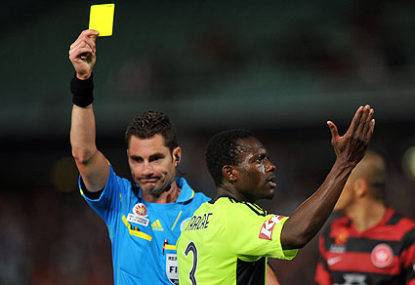Mariners star striker Torres charged with aggravated sexual assault and given 'no-fault' suspension
Central Coast Mariners' star striker Angel Torres has been stood down from playing in the A-League Men after he was charged with sexual assault. …

Three games over the past two weeks have provided an insight into how teams that have had a player sent off early have still been able to gain a point or three by adopting varying strategies, none better than the Melbourne Victory’s effort on Saturday night.
While one might point to the inability of the opponent to crack a team with 10 men, it’s also an indication of the growing tactical maturity of not only the A-League managers, but the players, able to execute plans against greater numbers.
There were two examples in round seven, with the Central Coast Mariners hanging on for a share of the points away to the Victory despite having Patrick Zwaanswijk sent off early in the second half, before the Western Sydney Wanderers held on for a spirited win in Perth despite having Youssef Hersi red carded on 37 minutes.
While both the Mariners and Wanderers appeared happy enough to hang on for their respective draw and win, there was a different approach from the Victory at Parramatta Stadium when they had Sam Gallagher sent off for pulling down Dino Kresinger on 16 minutes.
Rather than sit back on their 18 yard box and adjust to a 4-4-1, which both the Mariners and Wanderers did to great effect a week earlier, the Victory played it different.
Alternating between sitting deep and playing a higher defensive line, where they would squeeze the Wanderers, Ange Postecoglou’s team were able to adjust perfectly to the loss of a man, still maintaining a nice balance between defence and attack.
In many ways Postecoglou has the perfect team to adjust to playing with a man down, especially when you consider the player sent off wasn’t Archie Thompson or Marco Rojas.
That’s because those two fliers are instrumental to the way Postecoglou has set up his system.
With their pace and ability to stretch an opponent’s defence with penetrating runs off the ball, or incisive dribbles on it, they are crucial to the way the Victory go about their business.
Inevitably, the Victory build-up is about an incisive combination between the two central defensive midfielders (usually Billy Celeski and Mark Milligan) and two central attackers (usually Gui Finkler and Marcos Flores), before an incisive ball in behind the opponent for Thompson or Rojas to round up and square across the box for the other to tap in.
Patience, patience, patience, patience, then bang.
On Saturday, when Gallagher was dismissed, Postecoglou was fortunate he had Milligan there, able to move him from midfield to defence. That was seamless.
It meant, however, that Finkler would have to drop into the holding midfield, a move that would deprive the Victory of much creativity and link-up.
But Postecoglou had other plans. On came holder Jonathan Bru for unfortunate attacker Andrew Nabbout, who was by then playing in the false 9 role that had become the domain of Flores this season.
It meant a move back higher up the pitch for Finkler, into a role that was more than an attacking midfielder and not quite a number 9.
He took up a position behind Rojas and Thompson, but in front of the two screeners, Bru and Billy Celeski, and proceeded to help them dictate terms, getting on the ball, passing it, carrying it, and influencing with his strength, skill and silky movement.
Rarely has Aaron Mooy had his hands so full this season, struggling to get a foot in to make a challenge.
Indeed, while the Wanderers dominated possession, the Victory always relieved pressure through the ability of Celeski, Bru and Finkler to keep it, and then prompted both Rojas and Thompson, who always looked a threat in transition.
The more Tony Popovic’s men pushed on, the more tight they became, concerned by the damage Thompson and Rojas always threatened to inflict.
Postecoglou’s adjustment to a 4-2-1-2 was brilliant in its execution and exciting to watch up close.
For the Wanderers, a team more comfortable at reacting, it was a reminder that they need to develop a greater cutting edge, particular in the number 9 role, where Kresinger, for all his hard work, still lacked a final product.
The shoe was on the other foot for both the Wanderers and the Victory a week earlier, where the former was happy to sit and protect their early lead, while the latter struggled to get in behind a deep-sitting Mariners.
Both the Wanderers and Mariners adjusted to the loss of a man by going to a more flat midfield, with two lines of four and one up front.
The Mariners brought on Anderson for Tom Rogic, with John Hutchinson dropping from the left side of a midfield diamond to screen the midfield alongside Nick Montgomery, with Mile Sterjovski and Michael McGlinchey playing wide, while Daniel McBreen and later Bernie Ibini foraged alone up front.
The next night Popovic did something similar. When Hersi was sent off, Mooy went from the number 10 role to the right side of midfield, with Mark Bridge occupying the other flank, all behind a lone striker, Kresinger.
At half time Mooy reverted to a screening role as the defensive Shannon Cole came on on the right side of midfield.
Both Popovic and Arnold’s men were able to deny their opponent space and remain compact, even if they rarely threatened on the counter.
The Victory also did the defensive aspect extremely well on Saturday, keeping their first clean sheet of the season, but offered more sting on the counter, a perfectly executed strategy playing one short.